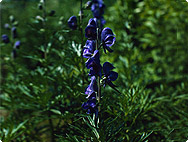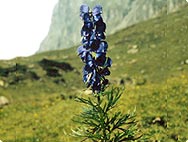A.Vogel search
When the internal search is activated, personal data such as your IP address is transmitted to our search engine Cludo. Data is thus transferred to a third country. Please click here if you want to display the internal search. You can find more information on data protection here: Privacy policy.
Aconitum napellus L.
Aconite
History

The name Aconitum is derived from the Greek word akónitos, from akóne meaning whetstone, which in turn is made up of ak, meaning ‘pointed’ or ‘sharp’, and kônos, meaning ‘cone’. The name probably refers to the pointed leaves. Ancient popular etymology connected the name in part to the adjective akonitós, which means ‘invincible’ and in part to the name of the hill Akonitos in Pontus. This is the hill where Heracles brought the three-headed dog Cerberus from the Underworld and where, according to Ovid, the plant grew from the animal's slaver. The Latin species name napellus is derived from nápus, which means ‘tuber’ and refers to the shape of the roots. Aconitum was well known in antiquity. Medea is supposed to have murdered her son with it. It is also reported that Aristotle died of aconite poisoning. Dioscorides mentions that the root kills scorpions. Aconite was formerly used as a poison for arrows and to poison wolves – hence the common name, wolfsbane. Avicenna was the first to describe its use in nosebleeds, bleeding of the lung, dizziness, circulatory collapse, paralysis, consumption and epilepsy. The Chinese have used a narcotic composed of arum, hyoscyamus, datura and aconitum for centuries.
Botanical Characteristics
Aconite is a stately plant, which grows up to 1.5 metres in height with a thick blackish, tuberous, fleshy root. The erect, strong stalk is covered with trifid to pentafid, deeply notched, dark green leaves, which become smaller the higher up the stalk they are. The violet-blue flowers, whose uppermost sepals are helmet-shaped, are arranged in a tight cluster. The so-called helmet encloses two long-stemmed honey leaves (nectaries), which are also called ‘doves of Venus' chariot’. The fruits, in the form of three pods, develop with shiny black, three-edged seeds, winged on the margins. When the plant blooms, the tuber or nodule bearing the stalk develops a daughter tuber, which will provide nutrition for the plant that grows from the bud in the following year. Aconite flowers from June to August.
Habitat

Aconite can be found throughout Central Europe, from England to the Carpathian Mountains and from Portugal to Sweden, in mountainous locations and altitudes up to 3000 metres. It prefers rich, moist, and over-fertilised soils, grazing pastures and waste dumps.
Preparation
A.Vogel/Bioforce uses a homoeopathic mother tincture produced in accordance with the current Homöopathisches Arzneibuch (HAB) (New Official German Homoeopathic Pharmacopoeia) from the fresh whole plants of Aconitum napellus, collected when the plant begins to bloom. The potentisation of the dilution is carried out by manual shaking.
A.Vogel Blog – Natural and Healthy
Inspiration for a healthy life!



